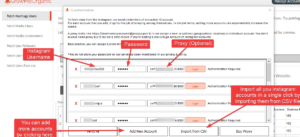A spam rate above 0.03%?
Complaint rates above 0.2%?
Email deliverability rate below 80%?
Fed up with your emails getting blocked or landing in spam?
If you’re seeing these email marketing stats, then it’s time to act fast! You’re not alone—it’s likely due to an “Email Blacklist.”
An email blacklist is a list of email addresses or domains marked as spammy. Being on an email blacklist means missed chances, reputation drops, and fewer emails getting through.
If you’re dealing with this, don’t stress! We’ve got your back. We’ll walk you through how to get your email off those blacklists and back into inboxes.
Our blog covers everything from finding out where you’re listed to fixing the issues. Find easy tips and practical strategies to boost your email deliverability.
What Is An Email Blacklist?
An email blacklist is a list of IP addresses, emails, and domains known for sending spam. ISPs and email providers use these lists to block unwanted emails.
You might hear them called DNS Blacklists (Domain Name System blocklist) or Real-Time Blackhole Lists (RBLs). Popular ones include SORBS, Spamhaus, and Barracuda.
There are two main blacklist types:
- Domain-based
- IP address-based
If you’re on a blacklist, your emails will likely end up in spam or not delivered at all.
How To Check If Your Email Is Blacklisted?
If your emails are blacklisted, then you will always get an undelivered email showing an error message.
But if you don’t receive any such message then you can monitor and notice a sudden drop in your delivery rates. One of the easiest ways to check an email blacklist is to approach common blacklist vendors and check directly.
These vendor websites have lookup tools, where you can enter the domain name or IP address and run a search.
Some of the email blacklist vendors –
You can also use email blacklist lookup tools to check if your IP or domain is blacklisted. Just enter your details and run a search. For free options, try MXToolbox or BlacklistAlert.
- MXToolbox offers handy tools for managing email and domains, including a blacklist checker. Enter your email or domain, and it’ll scan multiple blacklists to see if you’re listed.
- BlacklistAlert lets you quickly check if your email or domain is on any blacklists. Type your email or domain into the search box on their homepage to start the check.
![Email Blacklist Removal Guide [+ How To Check If Your Domain or IP Address is Blacklisted ] 5 email black lists](https://www.growmeorganic.com/wp-content/uploads/2024/08/Reddit-3.png)
Greg’s company had a major issue—they couldn’t send emails anymore because they were on multiple blacklists. He reached out to have them removed, but just a day later, they were back on the lists.
The longer this drags on, the worse it gets. Greg’s here to share his experience, explain what went wrong, and give us tips on how to avoid this problem.
How Does Your IP/Domain Gets Blacklisted?
Internet Service Providers like Gmail and Yahoo use spam filters to identify if an email is delivered, flagged as suspicious, or rejected.
Passing your emails from spam filters is essential in email marketing. Otherwise, your emails will land in the junk folder resulting in the blacklist.
Let’s go through some key reasons for getting blacklisted-
- Caught by spam traps.
- Recipient’s complaints.
- Email is used for fraudulent activities such as phishing and hacking etc.
- An IP address is involved in spam activities like bulletproof hosting and scrapers.
- Buying email lists.
- Using ISPs like Gmail or Yahoo for sending mass emails.
- Any other suspicious activities like many hard bounces and technical standards not being met.
How Will Email Blacklist Affect Your Business?
Email deliverability is most affected and you won’t be able to land emails into the recipient inbox. Email deliverability depends on the size and notoriety of the blacklist.
For example, if your domain ends up on a relatively small and unknown blacklist, then there are chances that the impact will be minimal you won’t even notice it.
But you are in trouble if you’re on a blacklist used by a major email provider. So, your emails will be rejected even before reaching the recipients. This will affect your email marketing campaigns.
What You Can Do if Your Domain Name/IP is on Email Blacklist?
Follow these three things when you find out you’re on an email blacklist:
Firstly know why this happened
- Did you change the email content?
- Did you email a new set of content?
- Is this a part of a new email campaign?
Request blacklist removal to email providers.
Blacklist vendors or ESP always have information available on their websites regarding blacklist removal.
Blacklist removal or delisting can be requested via a form or a link. After that, follow the steps and implement the recommended actions to improve your email practices.
Remember to have a set of rules for yourself so that you don’t appear on any ISP blacklists. Here are a few things you can do –
Avoid Getting Email Blacklist at the First Place
It is always better to avoid getting your email blacklisted for your email marketing performance and brand reputation. Let’s go through some email marketing best practices that will prevent your emails from getting blacklisted.
Diagnosing The Problem
To fix an email blacklisting, first, identify the blacklist affecting your email deliverability and understand why you were listed. Determine if it’s a single or multiple blacklists.
Common reasons include sudden email volume surges, high spam complaints, poor list hygiene, spam-like content, or suspected malware.
Addressing The Root Cause
Before requesting delisting, address and solve the root cause of your blacklisting. Simply asking for delisting without fixing issues can lead to repeated blacklisting.
Review sending practices, analyze content quality, enhance email authentication, assess infrastructure security, check recipient engagement, and monitor feedback loops.
Request Delisting
Finally, delisting involves different rules for each email blacklist. Some require a delisting request, while others automatically remove your domain after a certain period.
Here is an example of how to remove yourself from Spamhaus:
- Go to the Spamhaus website.
- Find the “Lookup IP or Domain” section.
- Enter your IP address or domain and hit “Lookup.”
- If you’re listed, follow the delisting instructions.
- You should explain what you’ve done to fix the problem and follow specific guidelines based on your listing type.
Take Consent
Always get consent and only send emails to those who have expressed their permission to you. You can implement a double opt-in process to confirm the subscriber’s intent for sign-up forms.
Double opt-in will protect you from spam traps. In the double opt-in, a potential subscriber fills out and submits a signup form online. Then, they’ll receive a confirmation email and click on a link to verify their email.
Update Your Contact List
User engagement has a direct impact on email deliverability. If a recipient has not opened an email for six months, it’s time to remove it from your contact list. Unengaged contacts can mark you as spam. So, it is always better to remove them along with any unsubscribes and inactive addresses.
Avoid Sending Mass Emails
Webmail providers such as Gmail and Yahoo are mostly used for sending personal emails. If you send mass emails, these ISPs will mark them as suspicious. The best way to send and manage mass email campaigns is to use a dedicated email marketing service and be aware of its email limits.
Monitor Campaign Analytics
If you notice a sudden drop in your email open rates, track campaign analytics closely. This will help you to implement a solution quickly in the event of a deliverability issue or blacklisting.
Check Sender’s Reputation
A sender’s reputation is one of the main criteria used by ISPs to check if you’re a bad sender or not. Your email-sending reputation depends on how your emails have performed in the past also whether or not your domain has been flagged for suspicious activity.
You should check up on it using tools like Senderscore.
Never Use Spam Words In Subject Lines Or Email Copy.
Specific phrases and words trigger spam filters. Avoid spam words to run your email campaign smoothly.
Never Buy Email Lists
Buying a list from some random source will have contacts of people who might not be interested in your offerings. If you send them repetitive emails or follow-ups, they can mark you as spam.
Also, contact lists are full of spam traps. Spam traps are inactive email addresses that has been purposely left out in the open by ISPs and blacklist vendors.
The email address is inactive, so the ISP knows that any email received will be unsolicited. This identifies the sender as a spammer.
6 Best Practices to Avoid Email Blacklisting In Future
Here are some tips to avoid being on any blacklist again.
1. Build Email Lists Organically
Building an email list organically means you get genuinely interested subscribers, reducing getting flagged and keeping your sender reputation strong.
Offer valuable resources like e-books or guides in exchange for email sign-ups. Host relevant webinars or events and encourage attendees to join your email list. Use a double opt-in process to confirm subscribers’ email addresses and ensure consent.
2. Verify Lists In Real Time
Real-time email verification ensures your emails reach the right audience. It filters out spam form submissions and invalid addresses, lowering bounce rates and spam complaints.
Tools like GrowMeOrganic use advanced algorithms to detect invalid emails and spam traps, enhancing deliverability and preventing blacklisting.
3. Monitor Your Email Sending
Monitoring your email practices is vital to avoiding blacklisting. Start by warming up your email, but wait to send large volumes. Gradually increase the number to build a good reputation with ISPs.
- Avoid excessive capitalization, exclamation marks, and misleading subject lines. Keep your content relevant and precise.
- Begin with non-promotional emails like newsletters or industry updates. This helps build positive engagement before sending personalized emails.
- Regularly monitor your email metrics like open rates, click-through rates, and spam complaints. This helps maintain a healthy score and keeps you off blacklists.
4. Using Active Opt-ins
Using single opt-in can quickly grow your email list, but it’s risky. Without a confirmation step, you might get fake or mistyped emails, leading to bounces.
Double opt-in, on the other hand, requires an extra confirmation step. This ensures only genuinely interested people join your list, reducing complaints and spam reports.
5. Removal of Inactive Subscribers
Keep your email list clean. If some subscribers aren’t engaging or opening your emails, it’s normal. Try a re-engagement campaign for them.
Always include an unsubscribe link in your marketing emails so people can easily opt out. If users still don’t open your emails, remove them from your list because inactive subscribers can hurt your email deliverability.
6. Do Not Link To Disreputable Sites
Another thing to watch out for with email issues is links. Linking to sites outside your domain or using link shorteners can look suspicious to security providers and might get you blacklisted.
It can also happen that you are not sending bulk emails, still getting blacklisted. This can result from shared servers. Konstantinos shares on Quora how you can solve it with a static IP, dedicated server, and more!
![Email Blacklist Removal Guide [+ How To Check If Your Domain or IP Address is Blacklisted ] 7 check email blacklists](https://www.growmeorganic.com/wp-content/uploads/2024/08/Quora-4.png)
Final Thoughts
Both public and private groups keep email blacklists, and email providers often have their lists too.
Blacklists block spam, but sometimes they might mistakenly flag innocent senders. The real goal of blacklists isn’t to stop your emails but to help improve your campaign, even if it takes a bit of time and effort.
To stay off blacklists, hand-pick and regularly clean your mailing list, and align it with what your subscribers want. If you do end up on a blacklist, removing yourself is usually straightforward.
A smart move is to address issues before they arise. Regularly check for blacklist issues and ask to be removed if needed. With these steps and some expert help, you can stay off the blacklist radar!
FAQs –
- What Does Blacklisted Mean?
Being blacklisted means your IP address or domain is listed as a source of spam or malicious activity. This can lead to your emails being blocked or your website being flagged by security systems.
- Is It Possible To Remove Your Ip Or Domain From A Blacklist?
Yes, you can remove your IP or domain from a blacklist. You’ll need to follow the specific delisting process outlined by the blacklist operator, which often involves addressing any issues and providing necessary details.
- What Are The Different Email Blacklist Services?
Email blacklist services, like Spamhaus, Barracuda, and SORBS, track and list email addresses or domains that send spam or engage in malicious activities. These lists help email providers block unwanted messages and protect users from spam.
- Who Influences The Email Blacklist?
Spam reports from users, automated spam detection systems, and the behavior of email servers influence email blacklists. If your email practices raise red flags, it could lead to blacklisting.
- What Behavior Gets You Listed In Email Blacklist?
You get listed on an email blacklist for sending spam, having a compromised email account, or using poor email practices like high bounce rates. It’s mainly about actions that make you look like a spammer or cause email abuse.
- How To Check If Email Is On Spam List?
Use email blacklist checkers online like MXToolBox that analyze different blacklists in real time. All you need to do is enter your domain or IP address for a quick check.
About Post Author
Anant Gupta
Growth Hacker, Marketing Automation Enthusiast & Founder of GrowMeOrganic






![[2024] Best LinkedIn Recommendation Examples: How to write LinkedIn Endorsements?](https://www.growmeorganic.com/wp-content/uploads/2024/06/linkedin-recommendation-300x169.jpg)

